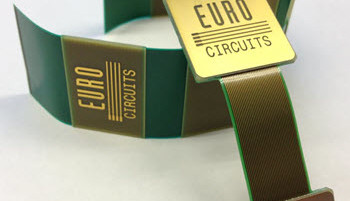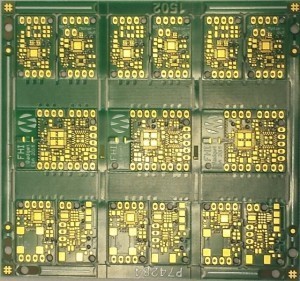Review: Eurocircuits’ SEMI-FLEX pool for semi-flexible PCBs
July 29, 2016
on
on

Are you looking for a flexible PCB but you find the polyimide variant to be too expensive? Then take a look at the SEMI-FLEX solution from Eurocircuits and see whether that is an option for you. In this month's Review we take a closer look at the features of this service.
Via the SEMI-FLEX pool you have access to a remarkable production process at Eurocircuits. The product is really exactly what it's called: a semi-flexible PCB. Semi-flexible means that you can bend the circuit board a limited number of times, typically about five times, before it potentially develops a problem. This is ideal for products in which various circuit boards are mounted at different angles to each other and there is no requirement for ongoing flexibility. The circuit board only needs to be bent into the desired shape once, during assembly, after which it is not actually flexed any more.
Working with a flexible circuit board has the advantage that no fragile (wire) interconnects are required. Connectors can oxidize and make poor contact after a period of time, which compromises the safety and reliability of the product. By reducing the number of connectors the number of solder joints is also reduced, which also has a positive influence on the reliability. It simplifies the production process: there is no need to manufacture special interconnect cable looms and install them by hand.
 The SEMI-FLEX pool from Eurocircuits does not use expensive polyimide material, but uses a thin layer of 'standard' FR4 instead. This layer is laminated on both sides with a copper layer. The material does not receive any special treatment to enable it to be bent a few times without breaking it. The semi-flexible circuit board is manufactured with four available copper layers, where the flexible part consists only of the 'core' – the thin FR4 layer with a copper layer on both sides. The flexible connection between two circuit boards is therefore not 4-layer, but 2-layer. The angle and the radius that the board is allowed to make are defined. We will look into the details on the next page.
The SEMI-FLEX pool from Eurocircuits does not use expensive polyimide material, but uses a thin layer of 'standard' FR4 instead. This layer is laminated on both sides with a copper layer. The material does not receive any special treatment to enable it to be bent a few times without breaking it. The semi-flexible circuit board is manufactured with four available copper layers, where the flexible part consists only of the 'core' – the thin FR4 layer with a copper layer on both sides. The flexible connection between two circuit boards is therefore not 4-layer, but 2-layer. The angle and the radius that the board is allowed to make are defined. We will look into the details on the next page.
To summarize:
Via the SEMI-FLEX pool you have access to a remarkable production process at Eurocircuits. The product is really exactly what it's called: a semi-flexible PCB. Semi-flexible means that you can bend the circuit board a limited number of times, typically about five times, before it potentially develops a problem. This is ideal for products in which various circuit boards are mounted at different angles to each other and there is no requirement for ongoing flexibility. The circuit board only needs to be bent into the desired shape once, during assembly, after which it is not actually flexed any more.
Working with a flexible circuit board has the advantage that no fragile (wire) interconnects are required. Connectors can oxidize and make poor contact after a period of time, which compromises the safety and reliability of the product. By reducing the number of connectors the number of solder joints is also reduced, which also has a positive influence on the reliability. It simplifies the production process: there is no need to manufacture special interconnect cable looms and install them by hand.
 The SEMI-FLEX pool from Eurocircuits does not use expensive polyimide material, but uses a thin layer of 'standard' FR4 instead. This layer is laminated on both sides with a copper layer. The material does not receive any special treatment to enable it to be bent a few times without breaking it. The semi-flexible circuit board is manufactured with four available copper layers, where the flexible part consists only of the 'core' – the thin FR4 layer with a copper layer on both sides. The flexible connection between two circuit boards is therefore not 4-layer, but 2-layer. The angle and the radius that the board is allowed to make are defined. We will look into the details on the next page.
The SEMI-FLEX pool from Eurocircuits does not use expensive polyimide material, but uses a thin layer of 'standard' FR4 instead. This layer is laminated on both sides with a copper layer. The material does not receive any special treatment to enable it to be bent a few times without breaking it. The semi-flexible circuit board is manufactured with four available copper layers, where the flexible part consists only of the 'core' – the thin FR4 layer with a copper layer on both sides. The flexible connection between two circuit boards is therefore not 4-layer, but 2-layer. The angle and the radius that the board is allowed to make are defined. We will look into the details on the next page.To summarize:
- SEMI-FLEX pool offer a higher reliability through fewer fragile connectors and cable looms, and fewer solder joints.
- Less time is required for assembly
- SEMI-FLEX pool uses FR4 material, which is much more affordable than polyimide.
Read full article
Hide full article



Discussion (0 comments)